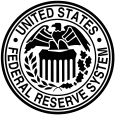U.S. Federal Reserve
|
|||
| Headquarters | Eccles Building, Washington, D.C., U.S. | ||
|---|---|---|---|
| Established | December 23, 1913 | ||
| Chair | Janet Yellen | ||
| Central bank of | United States | ||
| Currency |
United States dollar USD (ISO 4217) |
||
| Reserve requirements | 0 to 10% | ||
| Bank rate | 0.6% to 1.50% | ||
| Interest rate target | 0.5% to 0.75% | ||
| Interest on reserves | 0.25% | ||
| Interest paid on excess reserves? | Yes | ||
| Website | Official website | ||
The Federal Reserve System (also known as the Federal Reserve or simply the Fed) is the central banking system of the United States. It was created on December 23, 1913, with the enactment of the Federal Reserve Act in response to a series of financial panics (particularly the panic of 1907) that showed the need for central control of the monetary system if crises are to be avoided. Over the years, events such as the Great Depression in the 1930s and the Great Recession during the 2000s led to the expansion of the roles and responsibilities of the Federal Reserve System.
The U.S. Congress established three key objectives for monetary policy in the Federal Reserve Act: maximizing employment, stabilizing prices, and moderating long-term interest rates. The first two objectives are sometimes referred to as the Federal Reserve's dual mandate. Its duties have expanded over the years, and as of 2009[update] also include supervising and regulating banks, maintaining the stability of the financial system and providing financial services to depository institutions, the U.S. government, and foreign official institutions. The Fed conducts research into the economy and releases numerous publications, such as the Beige Book.
The Federal Reserve System's structure is composed of the presidentially appointed Board of Governors or Federal Reserve Board (FRB), partially presidentially appointed Federal Open Market Committee (FOMC), twelve regional Federal Reserve Banks located in major cities throughout the nation, numerous privately owned U.S. member banks, and various advisory councils. The federal government sets the salaries of the board's seven governors. Nationally chartered commercial banks are required to hold stock in the Federal Reserve Bank of their region, which entitles them to elect some of their board members. The FOMC sets monetary policy and consists of all seven members of the Board of Governors and the twelve regional bank presidents, though only five bank presidents vote at any given time: the president of the New York Fed and four others who rotate through one-year terms. Thus, the Federal Reserve System has both private and public components to serve the interests of the public and private banks. The structure is considered unique among central banks. It is also unusual in that the United States Department of the Treasury, an entity outside of the central bank, prints the currency used. The Federal Reserve System considers itself "an independent central bank because its monetary policy decisions do not have to be approved by the President or anyone else in the executive or legislative branches of government, it does not receive funding appropriated by the Congress, and the terms of the members of the Board of Governors span multiple presidential and congressional terms."
...
Wikipedia


